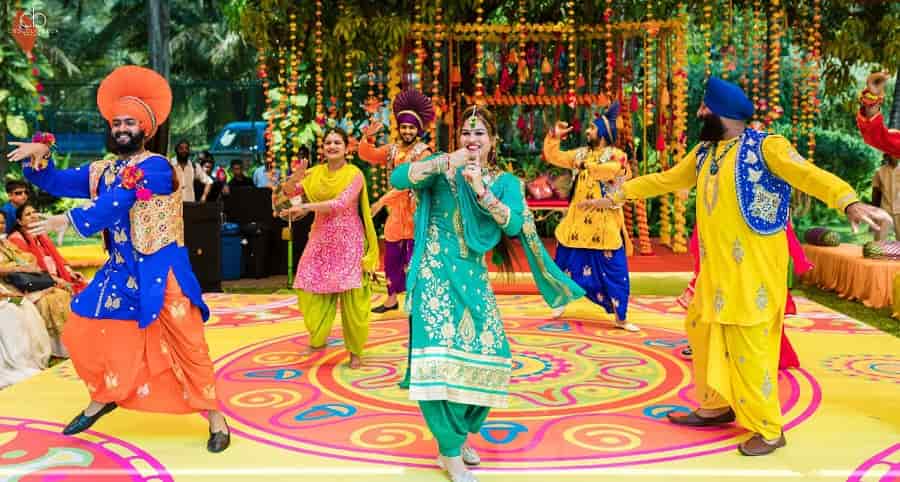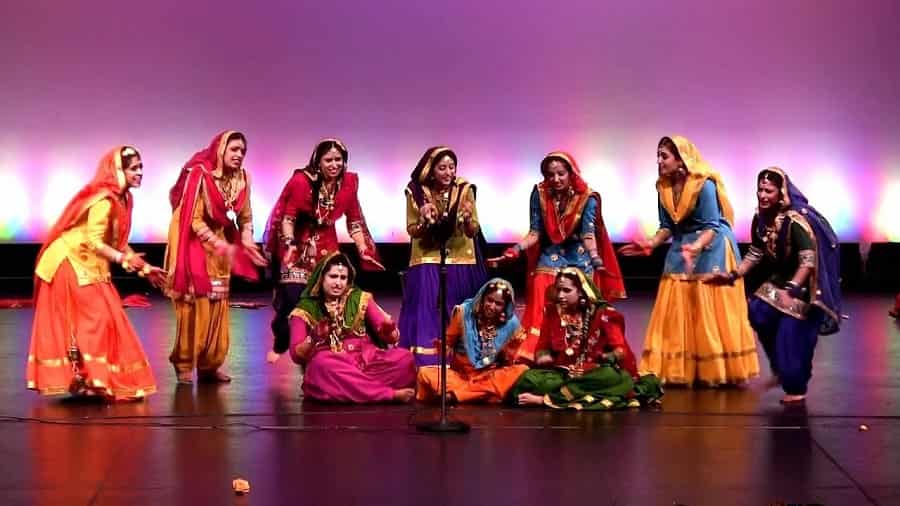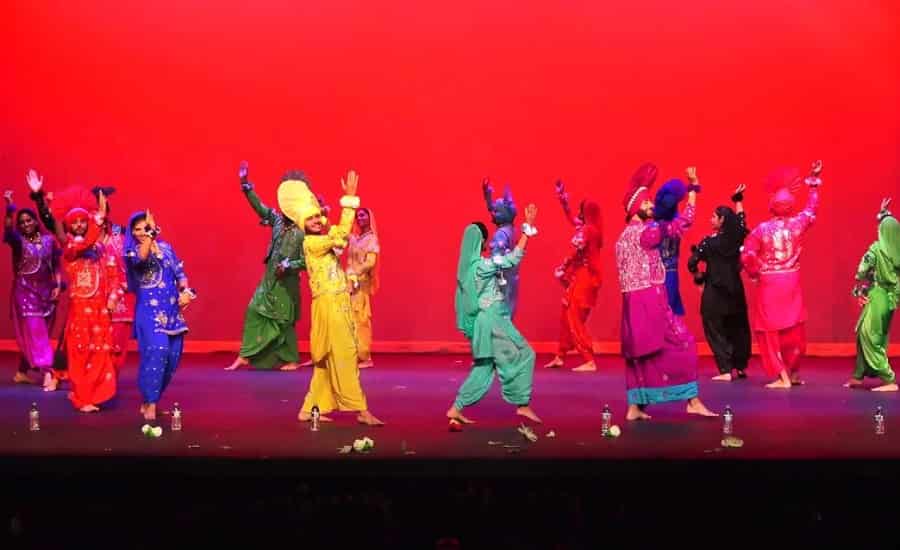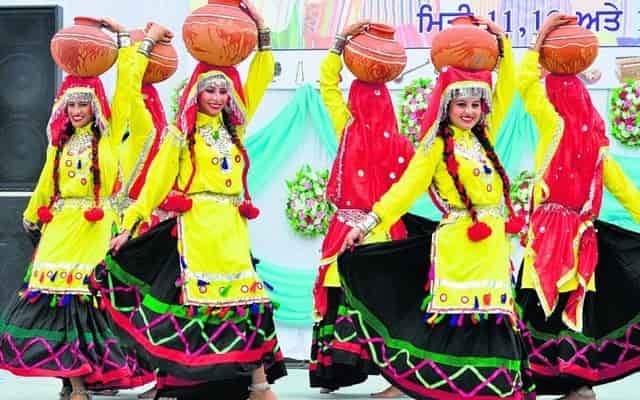Punjab, a land known for its lively spirit and rich cultural heritage, is home to a vibrant array of folk dances. These dances not only entertain but also serve as a medium to express emotions, celebrate festivals, and narrate stories of the region. From the energetic and rhythmic Bhangra to the graceful and vibrant Giddha, Punjab’s folk dances showcase the exuberance, traditions, and history of the land. In this article, we will take you on a mesmerizing journey, exploring the full information on folk dance of Punjab, uncovering their origins, significance, and the unique elements that make them an integral part of the Punjabi culture.
The Colorful World of Bhangra
Bhangra, the most widely recognized folk dance of Punjab, is an exuberant and lively form of dance that originated from the farming communities of the region. It is characterized by its energetic movements, foot-tapping beats, and infectious rhythm that instantly uplifts the mood of the participants and spectators alike.

Origins of Bhangra
Bhangra traces its roots back to the ancient times when it was performed as a celebratory dance during the harvest season. It was a way for the farming community to express their joy and gratitude for a bountiful harvest. Over the years, Bhangra has evolved, incorporating elements from various cultures and styles, and has become a prominent dance form not only in Punjab but also across the globe.
Elements of Bhangra
Bhangra is characterized by its distinct elements that contribute to its vibrant and energetic nature. The dance involves energetic and synchronized movements, footwork, acrobatic jumps, and lively hand gestures. The beats of traditional Punjabi instruments like the dhol and the dholak create the rhythmic foundation for Bhangra, and the dancers synchronize their movements with the beats, creating an electrifying atmosphere.
Bhangra Costumes and Accessories
The traditional attire of Bhangra dancers adds to the visual appeal and cultural significance of the dance. Men typically wear a vibrant and colorful ensemble known as a kurta pajama, paired with a colorful vest and a turban. Women, on the other hand, wear a bright and colorful salwar kameez or lehenga choli, along with traditional jewelry and accessories.
Popular Bhangra Songs
Bhangra is incomplete without its soul-stirring music. Popular Bhangra songs are a combination of traditional Punjabi folk music, modern beats, and catchy lyrics. Some famous Bhangra songs include “Bolo Tara Rara” by Daler Mehndi, “Mundiyaan To Bach Ke” by Panjabi MC, and “Gur Nalo Ishq Mitha” by Malkit Singh, among many others.
The Elegance of Giddha
Giddha, a traditional folk dance of Punjab performed exclusively by women, is characterized by its graceful and vibrant movements. It is a celebration of femininity, joy, and camaraderie among women.

Historical Background of Giddha
Giddha has its roots in the rich cultural traditions of Punjab and has been practiced for centuries. It was initially performed during festivals and social gatherings, where women would come together to sing and dance, expressing their emotions and storytelling through rhythmic movements.
Giddha Movements and Gestures
Giddha is known for its elegant movements, graceful twirls, and synchronized clapping. The dancers form a circle, and the lead performer leads the dance by starting a verse or singing a folk song. The other dancers join in, following the lead, and the dance progresses with a seamless blend of movements and gestures.
Giddha Costumes and Ornaments
The attire worn during Giddha performances adds to the visual splendor of the dance. Women typically wear a colorful salwar kameez or lehenga choli, adorned with traditional jewelry such as bangles, earrings, and necklaces. The vibrant costumes and shimmering ornaments create a captivating visual display.
Famous Giddha Performances
Giddha has gained recognition not only in Punjab but also on national and international platforms. Many talented Giddha performers have showcased their skills and talent through competitions, cultural events, and television shows, bringing the beauty of Giddha to a wider audience.
The Lively Celebration of Jhumar
Jhumar is a lively folk dance that originated in the Sandalbar region of Punjab. It is a joyful and celebratory dance performed on various occasions, such as weddings, festivals, and social gatherings.

The Origins of Jhumar
Jhumar originated as a dance form performed by the Sandalbar tribes to celebrate the successful completion of agricultural work. It has since become an integral part of Punjabi culture, symbolizing happiness, prosperity, and togetherness.
Jhumar Dance Movements
Jhumar is characterized by its lively and energetic movements. The dancers form a circle and move in a synchronized manner, performing quick footwork, twirls, and jumps. The energetic beats of the dhol and the chimta, a traditional Punjabi percussion instrument, add to the vibrancy of the dance.
Jhumar Costumes and Music
The traditional attire worn during Jhumar performances reflects the cultural heritage of Punjab. Men wear a colorful kurta and lungi, while women dress in vibrant salwar kameez or lehenga choli. The music accompanying Jhumar is upbeat and lively, creating an atmosphere of joy and celebration.
Folklore and Legends Associated with Jhumar
Jhumar has deep cultural roots and is often accompanied by storytelling. Many folk songs and verses associated with Jhumar narrate tales of valor, love, and historical events, keeping the traditions and history of Punjab alive.
The Expressive Narrative of Sammi
Sammi is a traditional folk dance that originated in the Sandalbar region of Punjab. It is a narrative dance form that tells stories of separation, longing, and love.

Sammi’s Historical Significance
Sammi has its origins in the historical and social context of Punjab, particularly among women who had to bid farewell to their loved ones during times of war and migration. The dance served as a medium to express their emotions, and it continues to be performed to this day, keeping the history and stories alive.
Sammi Dance Movements and Style
Sammi is a graceful dance form characterized by slow and expressive movements. The dancers convey the emotions of the song through subtle gestures and facial expressions. The dance is performed in a circular formation, with the lead performer narrating the story through verses and the other dancers following along.
Sammi’s Cultural Impact
Sammi has not only preserved the stories and emotions of the past but has also become a symbol of strength, resilience, and the indomitable spirit of the Punjabi women. It is performed on various occasions, including weddings, cultural events, and festivals, showcasing the cultural richness and heritage of Punjab.
Gatka
Gatka is a traditional martial art form that originated in Punjab. It combines combat techniques, swordplay, and self-defense movements. Gatka is not only a dance but also a form of physical and mental discipline.
Jalli
Jalli is a folk dance form that showcases the agility and skill of dancers. It involves balancing earthen pots on the head while performing intricate footwork and graceful movements. Jalli is often performed during weddings and festive occasions.
Kikli
Kikli is a playful and energetic dance form performed by young girls. The dancers hold hands and form a circle, spinning and twirling with rhythmic steps. Kikli is a joyous dance that symbolizes friendship and unity.
Malwai Giddha
Malwai Giddha is a regional variant of Giddha, specific to the Malwa region of Punjab. It incorporates unique movements, footwork patterns, and musical variations. Malwai Giddha showcases the cultural diversity within the realm of Giddha.
Jaago
Jaago is a traditional dance performed by women during wedding celebrations. It involves carrying a decorated earthen pot on the head, adorned with lit candles or an oil lamp. The dancers move in a procession, singing and dancing to bless the bride and groom.
Luddi
Luddi is a lively and energetic dance form traditionally performed by men. It is characterized by vigorous movements, jumps, and high-energy footwork. Luddi is often accompanied by rhythmic drumming and is a popular dance at festive occasions.
Dhamaal
Dhamaal is a dynamic and exuberant dance form performed during religious festivals and celebrations. It involves spinning and jumping to the beats of dhol, creating a joyous and celebratory atmosphere. Dhamaal is a captivating sight that engages both performers and spectators.
Jindua
Jindua is a popular folk dance form that originated in the Malwa region of Punjab. It involves intricate footwork, synchronized movements, and graceful spins. Jindua is often performed during cultural festivals and is known for its elegance and charm.
Jugni
Jugni is a traditional dance form that combines elements of singing and dancing. It involves a solo performer or a group of performers singing folk songs while dancing. Jugni is a versatile dance form that expresses a range of emotions, from joy to sorrow.
These are just a few examples of the diverse folk dances from Punjab. Each dance form carries its unique charm, cultural significance, and historical roots. Exploring the rich tapestry of Punjab’s folk dances allows us to appreciate the artistic expressions and traditions that have shaped the region’s cultural landscape.
FAQs:
Q: What is the significance of folk dances in Punjab?
A: Folk dances in Punjab hold immense cultural significance as they represent the traditions, history, and emotions of the region. They serve as a medium of expression, celebration, and storytelling.
Q: How do Bhangra and Giddha differ from each other?
A: Bhangra is a lively dance performed by both men and women, while Giddha is an elegant dance form performed exclusively by women. The movements, costumes, and music of Bhangra and Giddha vary, reflecting their distinct styles.
Q: Are there any specific occasions when these folk dances are performed?
A: Yes, these dances are performed on various occasions like weddings, festivals, harvest celebrations, and social gatherings. They bring joy, entertainment, and cultural richness to these events.
Q: Can anyone learn and perform these folk dances?
A: Absolutely! Bhangra and Giddha are open to anyone who is interested in learning and experiencing the rich cultural heritage of Punjab. Many dance schools and cultural organizations offer classes and workshops for beginners and enthusiasts.
Q: Are these folk dances still popular in modern-day Punjab?
A: Yes, Bhangra and Giddha continue to be popular in Punjab and have gained global recognition. They are performed not only in traditional settings but also in music videos, cultural festivals, and international dance competitions.
Q: What is the future of folk dances in Punjab?
A: Despite the influence of modernization and changing cultural dynamics, folk dances in Punjab continue to thrive. They are embraced as a way to connect with one’s roots, preserve cultural heritage, and celebrate the diversity of Punjab.
Conclusion:
The folk dances of Punjab, including Bhangra, Giddha, Jhumar, and Sammi, are a testament to the vibrant and rich cultural heritage of the region. These dances have transcended time and boundaries, bringing joy, celebration, and a sense of unity to people around the world. By preserving and promoting these traditional dance forms, we ensure that the vibrant legacy of Punjab’s folk dances lives on, inspiring generations to come.



